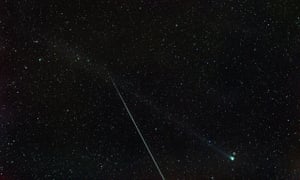This will be a good meteor show to see from the southern hemisphere,
but you’ll need to be up early, experts say. See where, when and how to
watch in Australia
If you want to see what happens when a piece of dust from the tail of
a comet hits the earth’s atmosphere at about 60km per second, then look
roughly east in the early hours of Wednesday.
Between about 2am and 5am, the annual Eta Aquarids meteor shower will peak during the Earth’s journey through the orbit of Comet Halley and the trail of dust it leaves behind.
“This is a good one to see from the southern hemisphere, but you’ll need to be up in the early morning hours,” says Prof Michael Brown, an astrophysicist at Monash University in Melbourne.
“Comets are dirty snowballs and they leave trails of dust in their orbits. When the Earth runs into that dust, we get meteor showers like the one we’ll get tomorrow morning.”
The particles may only be about the size of a grain of sand, but
Brown says the speed they travel as they hit the Earth’s atmosphere –
about 60km per second – means they “burn up quite spectacularly and
produce a nice shooting star”.Between about 2am and 5am, the annual Eta Aquarids meteor shower will peak during the Earth’s journey through the orbit of Comet Halley and the trail of dust it leaves behind.
“This is a good one to see from the southern hemisphere, but you’ll need to be up in the early morning hours,” says Prof Michael Brown, an astrophysicist at Monash University in Melbourne.
“Comets are dirty snowballs and they leave trails of dust in their orbits. When the Earth runs into that dust, we get meteor showers like the one we’ll get tomorrow morning.”
He said: “They’re a bit like buses – you might wait for a while and then you might see three in a minute.”
Horner says it takes the Earth about a month to go through the path of the dust trail, but early on Wednesday we will travel through the densest part. For the next few days people will still have a good chance to see meteors, he said.
Horner says the best approach will be to get outside at about 4.15am and look roughly east and give your eyes about 15 minutes to adjust.
He said it was best to lie down and look about 30 to 40 degrees above the horizon. The dust particles are burning up about 80km from the Earth’s surface.
Comet Halley is currently out around the orbit of Neptune and almost at its farthest distance away from the Earth before making a turn and heading back in our direction.
Comet Halley comes by the Earth every 76 years and was last here in 1986 and won’t be in our part of the solar system again until about 2061.
But Horner said the dust from Halley hitting the Earth now is likely not from the comet’s last venture here, but from a fly-by thousands of years ago.
Each time it reaches the warmer climes of the solar system, Horner says Halley loses about one metre from its surface. The comet itself formed at the same time as the solar system, about 4,500m years ago.
On Tuesday night, Horner captured a photograph of an Eta Aquarids meteor close to newly discovered Comet Swan.
If the sky is very clear and you’re away from town lights, then careful watchers may just be able to make out the blur of the comet – discovered on 11 April by Michael Mattiazzo, an amateur astronomer and member of the Astronomical Society of Victoria.
Con Stoitsis, the director of the society’s comet and meteor section, said his colleague Michael discovered the comet while studying images from an instrument aboard the Soho satellite, launched in 1995. Comet Swan is named after the instrument – the Solar Wind ANisotropies instrument – that took the image.
“I have seen the comet three times – it’s a bit brighter than anticipated,” said Stoitsis. “Not many people in the world have seen it.”
He said people would be lucky to see Comet Swan with the naked eye, but it was in the same part of the sky that people would be looking at to see the meteors.
He said: “It’s going to be a good time to get out there and there’s a window between about 5am and 5.30am when there’s no moon. You might see 15 or 20 meteors an hour under really good conditions.”
In October, the earth will again pass through Halley’s dust trail for a meteor shower called the Orionids which, Stoitsis said, did not tend to deliver as many meteors to the sky as the Eta Aquarids.

No comments:
Post a Comment